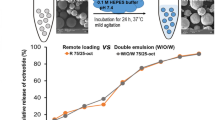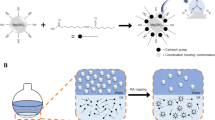Abstract
Purpose
The purpose of this study was to characterize and detail the mechanism of a smart Ca2+ release depot (Ca3(PO4)2) about its ability for sustainable inhibition on peptide acylation within PLGA microspheres.
Methods
The octreotide acetate release and acylation kinetics were analyzed by RP-HPLC. Changes of Ca2+ concentration and adsorption behavior were determined by a Calcium Colorimetric Assay Kit. The inner pH changes were delineated by a classic pH sensitive probe, Lysosensor yellow/ blue® dextran. Morphological changes of microspheres, adsorption between polymer and additive, transformation of Ca3(PO4)2 were characterized using SEM, FTIR and SSNMR separately.
Results
Before and after microspheres formulation, the property and effectiveness of Ca3(PO4)2 were investigated. Compared with a commonly used calcium salt (CaCl2), high encapsulation efficiency (96.56%) of Ca3(PO4)2 guarantees lasting effectiveness. In an increasingly acidic environment that simulated polymer degradation, the poorly water-soluble Ca3(PO4)2 could absorb protons and transform into the more and more soluble CaHPO4 and Ca(H2PO4)2 to produce sufficient Ca2+ according to severity of acylation. The corresponding Ca2+ produce capacity fully met the optimum inhibition requirement since the real-time adsorption sites (water-soluble carboxylic acids) inside the degrading microspheres were rare. A sustained retention of three switchable calcium salts and slow release of Ca2+ were observed during the microsphere incubation. FTIR results confirmed the long-term inhibition effect induced by Ca3(PO4)2 on the adsorption between drug and polymer.
Conclusions
With the presence of the smart Ca2+ depot (Ca3(PO4)2) in the microspheres, a sustainable and long-term inhibition of peptide acylation was achieved.












Similar content being viewed by others
Abbreviations
- PLGA:
-
Poly(D,L-lactic-co-glycolic acid)
- RP-HPLC:
-
Reversed phase high performance liquid chromatography
- SEM:
-
Scanning Electron Microscopy
- FTIR:
-
Fourier Transform Infrared Spectroscopy
- SSNMR:
-
Solid State Nuclear Magnetic Resonance
- PEG:
-
Polyethylene glycol
- CMCS:
-
O-Carboxymethyl chitosan
- Ca3(PO4)2 :
-
Calcium phosphate
- CaHPO4 :
-
Calcium hydrophosphate
- Ca(H2PO4)2 :
-
Calcium dihydrophosphate
- CaCl2 :
-
Calcium chloride
- Mw:
-
Molecular weight
- PVA:
-
Poly (vinyl alcohol)
- NaOH:
-
Sodium hydroxide
- HCl:
-
Hydrochloric acid
- TFA:
-
Trifluoroacetic acid
- PBST:
-
Phosphate buffer solution (0.02 wt.% Tween 80)
- HEPES:
-
2-[4-(2-Hydroxyethyl)-1-piperazinyl]ethanesulfonic acid
- PLA:
-
Polylactic acid
- PGA:
-
Polyglycolic acid
References
Y.W. Yi, M.H. Seo, B.O. Kim, I.J. Choi, H.J. Yoon, S.Y. Kim, S.J. Lee, and J.W. Cho. Macromolecule for delivering protein, polypeptide or peptide drugs and a production method for the same, and a slow release composition for protein, polypeptide or peptide drugs and a production method for the same, Google Patents (2017).
van Dijk F, Teekamp N, Beljaars L, Post E, Zuidema J, Steendam R, et al. Pharmacokinetics of a sustained release formulation of PDGFβ-receptor directed carrier proteins to target the fibrotic liver. J Control Release. 2018;269:258–65.
Chen L, Mei L, Feng D, Huang D, Tong X, Pan X, et al. Anhydrous reverse micelle lecithin nanoparticles/PLGA composite microspheres for long-term protein delivery with reduced initial burst. Colloids Surf B: Biointerfaces. 2018;163:146–54.
Vaishya RD, Mandal A, Gokulgandhi M, Patel S, Mitra AK. Reversible hydrophobic ion-paring complex strategy to minimize acylation of octreotide during long-term delivery from PLGA microparticles. Int J Pharm. 2015;489:237–45.
Sophocleous AM, Desai KG, Mazzara JM, Tong L, Cheng JX, Olsen KF, et al. The nature of peptide interactions with acid end-group PLGAs and facile aqueous-based microencapsulation of therapeutic peptides. Journal of controlled release : official journal of the Controlled Release Society. 2013;172:662–70.
Niu Z, Tedesco E, Benetti F, Mabondzo A, Montagner IM, Marigo I, et al. Rational design of polyarginine nanocapsules intended to help peptides overcoming intestinal barriers. J Control Release. 2017;263:4–17.
Wong CY, Al-Salami H, Dass CR. Microparticles, microcapsules and microspheres: a review of recent developments and prospects for oral delivery of insulin. Int J Pharm. 2017.
Dai C, Wang B, Zhao H. Microencapsulation peptide and protein drugs delivery system. Colloids Surf B: Biointerfaces. 2005;41:117–20.
Wei G, Jin L, Xu L, Liu Y, Lu W. Preparation, characterization and in vivo pharmacodynamic evaluation of thymopentin loaded poly (lactide acid)/poly (lactide-co-glycolide acid) implants. Int J Pharm. 2010;398:123–9.
Widmer J, Thauvin C, Mottas I, Nguyen VN, Delie F, Allémann E, et al. Polymer-based nanoparticles loaded with a TLR7 ligand to target the lymph node for immunostimulation. Int J Pharm. 2018;535:444–51.
Le Devedec F, Boucher H, Dubins D, Allen C. Factors controlling drug release in cross-linked poly (valerolactone) based matrices. Mol Pharm. 2018;15:1565–77.
Qi F, Wu J, Fan Q, He F, Tian G, Yang T, et al. Preparation of uniform-sized exenatide-loaded PLGA microspheres as long-effective release system with high encapsulation efficiency and bio-stability. Colloids Surf B: Biointerfaces. 2013;112:492–8.
Pai SS, Tilton RD, Przybycien TM. Poly (ethylene glycol)-modified proteins: implications for poly (lactide-co-glycolide)-based microsphere delivery. AAPS J. 2009;11:88–98.
Shpigel T, Uziel A, Lewitus DY. SPHRINT – printing drug delivery microspheres from polymeric melts. Eur J Pharm Biopharm. 2018;127:398–406.
Wischkeand C, Schwendeman SP. Principles of encapsulating hydrophobic drugs in PLA/PLGA microparticles. Int J Pharm. 2008;364:298–327.
Wang J, Wang BM, Schwendeman SP. Characterization of the initial burst release of a model peptide from poly (D, L-lactide-co-glycolide) microspheres. J Control Release. 2002;82:289–307.
Schwendeman SP. Recent advances in the stabilization of proteins encapsulated in injectable PLGA delivery systems, vol. 19; 2002. p. 26.
Giteau A, Venier-Julienne M-C, Marchal S, Courthaudon J-L, Sergent M, Montero-Menei C, et al. Reversible protein precipitation to ensure stability during encapsulation within PLGA microspheres. Eur J Pharm Biopharm. 2008;70:127–36.
He J-T, Su H-B, Li G-P, Tao X-M, Mo W, Song H-Y. Stabilization and encapsulation of a staphylokinase variant (K35R) into poly (lactic-co-glycolic acid) microspheres. Int J Pharm. 2006;309:101–8.
Murty SB, Goodman J, Thanoo B, DeLuca PP. Identification of chemically modified peptide from poly (D, L-lactide-co-glycolide) microspheres under in vitro release conditions. AAPS PharmSciTech. 2003;4:392–405.
Na DH, Youn YS, Lee SD, Son M-W, Kim W-B, DeLuca PP, et al. Monitoring of peptide acylation inside degrading PLGA microspheres by capillary electrophoresis and MALDI-TOF mass spectrometry. J Control Release. 2003;92:291–9.
Ghassemi AH, van Steenbergen MJ, Barendregt A, Talsma H, Kok RJ, van Nostrum CF, et al. Controlled release of octreotide and assessment of peptide acylation from poly (D, L-lactide-co-hydroxymethyl glycolide) compared to PLGA microspheres. Pharm Res. 2012;29:110–20.
Shirangi M, Hennink WE, Somsen GW, van Nostrum CF. Acylation of arginine in goserelin-loaded PLGA microspheres. European journal of pharmaceutics and biopharmaceutics : official journal of Arbeitsgemeinschaft fur Pharmazeutische Verfahrenstechnik eV, vol. 99; 2016. p. 18–23.
Na DH, De Luca PP. PEGylation of octreotide: I. separation of positional isomers and stability against acylation by poly (D, L-lactide-co-glycolide). Pharm Res. 2005;22:736–42.
Shirangi M, Hennink WE, Somsen GW, Van Nostrum CF. Identification and assessment of octreotide acylation in polyester microspheres by LC–MS/MS. Pharm Res. 2015;32:3044–54.
Sophocleous AM, Zhang Y, Schwendeman SP. A new class of inhibitors of peptide sorption and acylation in PLGA. J Control Release. 2009;137:179–84.
Shirangi M, Najafi M, Rijkers DT, Kok RJ, Hennink WE, van Nostrum CF. Inhibition of octreotide acylation inside plga microspheres by derivatization of the amines of the peptide with a self-immolative protecting group. Bioconjug Chem. 2016;27:576–85.
Lucke A, Kiermaier J, Göpferich A. Peptide acylation by poly (α-hydroxy esters). Pharm Res. 2002;19:175–81.
Göpferich ALA. Acylation of peptides by lactic acid solutions. Eur J Pharm Biopharm. 2003;55:27–33.
Na DH, Lee KC, DeLuca PP. PEGylation of octreotide: II. Effect of N-terminal mono-PEGylation on biological activity and pharmacokinetics. Pharm Res. 2005;22:743–9.
Ahn JH, Park EJ, Lee HS, Lee KC, Na DH. Reversible blocking of amino groups of octreotide for the inhibition of formation of acylated peptide impurities in poly (lactide-co-glycolide) delivery systems. AAPS PharmSciTech. 2011;12:1220–6.
Zhang Y, Sophocleous AM, Schwendeman SP. Inhibition of peptide acylation in PLGA microspheres with water-soluble divalent cationic salts. Pharm Res. 2009;26:1986–94.
Zhangand Y, Schwendeman SP. Minimizing acylation of peptides in PLGA microspheres. Journal of controlled release : official journal of the Controlled Release Society. 2012;162:119–26.
Wright ME. Side-chain and end-group modified poly-p-phenylene oligomers. In: Google Patents2015.
Wang J, Wang BM, Schwendeman SP. Mechanistic evaluation of the glucose-induced reduction in initial burst release of octreotide acetate from poly (D, L-lactide-co-glycolide) microspheres. Biomaterials. 2004;25:1919–27.
Liu Y, Ghassemi AH, Hennink WE, Schwendeman SP. The microclimate pH in poly(d,l-lactide-co-hydroxymethyl glycolide) microspheres during biodegradation. Biomaterials. 2012;33:7584–93.
Dingand AG, Schwendeman SP. Acidic microclimate pH distribution in PLGA microspheres monitored by confocal laser scanning microscopy. Pharm Res. 2008;25:2041–52.
Liuand Y, Schwendeman SP. Mapping microclimate pH distribution inside protein-encapsulated PLGA microspheres using confocal laser scanning microscopy. Mol Pharm. 2012;9:1342–50.
Loste E, Díaz-Martí E, Zarbakhsh A, Meldrum FC. Study of calcium carbonate precipitation under a series of fatty acid Langmuir monolayers using Brewster angle microscopy. Langmuir. 2003;19:2830–7.
Govers MJ, Termont DS, Lapré JA, Kleibeuker JH, Vonk RJ, Van der Meer R. Calcium in milk products precipitates intestinal fatty acids and secondary bile acids and thus inhibits colonic cytotoxicity in humans. Cancer Res. 1996;56:3270–5.
Zolnikand BS, Burgess DJ. Effect of acidic pH on PLGA microsphere degradation and release. J Control Release. 2007;122:338–44.
Rawat A, Stippler E, Shah VP, Burgess DJ. Validation of USP apparatus 4 method for microsphere in vitro release testing using Risperdal® Consta®. Int J Pharm. 2011;420:198–205.
Guand B, Burgess DJ. Prediction of dexamethasone release from PLGA microspheres prepared with polymer blends using a design of experiment approach. Int J Pharm. 2015;495:393–403.
Author information
Authors and Affiliations
Corresponding authors
Additional information
Publisher’s Note
Springer Nature remains neutral with regard to jurisdictional claims in published maps and institutional affiliations.
Electronic Supplementary Material
ESM 1
(DOCX 1923 kb)
Rights and permissions
About this article
Cite this article
Liu, J., Xu, Y., Wang, Y. et al. Proton Oriented-“Smart Depot” for Responsive Release of Ca2+ to Inhibit Peptide Acylation in PLGA Microspheres. Pharm Res 36, 119 (2019). https://doi.org/10.1007/s11095-019-2640-5
Received:
Accepted:
Published:
DOI: https://doi.org/10.1007/s11095-019-2640-5




